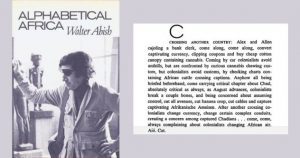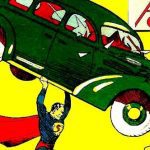 Our World
Our World  Our World
Our World  Movies and TV
Movies and TV 10 Times Twin Movies Competed with Each Other
 The Arts
The Arts 10 Masterpieces Plucked from the Artist’s Subconscious
 Crime
Crime 10 Fascinating Facts about Rikers Island
 Pop Culture
Pop Culture 10 Things You Might Not Know about Dracula
 Weird Stuff
Weird Stuff 10 Everyday Activities That Were Once Considered Illegal
 History
History Ten of History’s Hidden Secrets: Stories 99% Don’t Know About
 Movies and TV
Movies and TV 10 Actors Who Infamously Stormed Off Set While Filming
 Food
Food 10 Foods That Have Alleged Occult Powers
 Sport
Sport 10 Lesser-Known Multi-Sport Alternatives to the Olympics
 Our World
Our World Planet Earth’s 10 Most Hardcore Natural Creations
 Movies and TV
Movies and TV 10 Times Twin Movies Competed with Each Other
 The Arts
The Arts 10 Masterpieces Plucked from the Artist’s Subconscious
Who's Behind Listverse?

Jamie Frater
Head Editor
Jamie founded Listverse due to an insatiable desire to share fascinating, obscure, and bizarre facts. He has been a guest speaker on numerous national radio and television stations and is a five time published author.
More About Us Crime
Crime 10 Fascinating Facts about Rikers Island
 Pop Culture
Pop Culture 10 Things You Might Not Know about Dracula
 Weird Stuff
Weird Stuff 10 Everyday Activities That Were Once Considered Illegal
 History
History Ten of History’s Hidden Secrets: Stories 99% Don’t Know About
 Movies and TV
Movies and TV 10 Actors Who Infamously Stormed Off Set While Filming
 Food
Food 10 Foods That Have Alleged Occult Powers
 Sport
Sport 10 Lesser-Known Multi-Sport Alternatives to the Olympics
Ten Strange Books & the Strange Ways They Were Written
What makes a story strange? The plot, the writing, the characters, the formatting? Whether fiction or nonfiction, new or old, every book is a window into a vast new world, some stranger than others. No two novels are entirely alike. Humans have been captivated and confused by the written word for as long as there have been languages to write with. It only makes sense that in all that time, we have used our words in many weird and wonderful ways.
Related: 10 Books Banned In The 21st Century
10 I, Libertine
For much of its early existence, I, Libertine was a joke disguised as a book. The strangeness of I, Libertine comes not from the book itself but from the convoluted nature of how the book was conceived.
I, Libertine technically has three creators. The first was a radio D.J. named Jean Shepard, who, in 1956, had a grudge against the bestseller list. He believed publishers did nothing but follow the next big thing, and he intended to prove it. Shepard told his fans to visit their local books stores and ask for I, Libertine by Frederick R. Ewing, a historical novel that was never written by an author who didn’t exist.
Armed with a title, an author, and a basic plot, Shepherd’s fans made such a fuss about the book that booksellers were floundering far and wide to find copies; pre-sales did put I, Libertine on a few bestseller lists, though it is unclear whether it ever made the New York Times. It did, however, manage to get banned by the Archdiocese of Boston.
About a month later, the hoax was finally revealed by the Wall Street Journal. However, Jean Shepard eventually met with a publisher named Ian Ballantine and a writer named Theodore Sturgeon. On September 13, 1956, I, Libertine would be published for real, more than 12 months after the newspaper exposed the hoax. I Libertine’s author page has a picture of Shepard posing as the nonexistence author Frederick Ewing.[1]
9 Codex Seraphinianus
The Codex Seraphinianus is the first of several books on the list that cannot really be read. First published in Italy in 1981, the Codex Seraphinianus is an encyclopedia written in an imaginary language by the Italian artist and industrial designer Luigi Serafini. It is completely unintelligible. This incomprehensibility was entirely intentional on Serafini’s part.
The novel’s script isn’t a constructed language; it is a false language. “The book creates a feeling of illiteracy which, in turn, encourages imagination, like children seeing a book: They cannot yet read it, but they realize that it must make sense and imagine what its meaning must be… The writing of the Codex is a writing, not a language, although it conveys the impression of being one.”
Although the encyclopedia is unreadable, the illustrations more than make up for the initial confusion. The book’s science-fiction aesthetics inspire a stunning array of surreal imagery—a bird’s nest with legs, hippos made of clouds, and a couple shape-shifting into a crocodile are some of the most comprehensible pictures. The Codex’s 300 pages are divided into twelve chapters, six dedicated to nature and physics and six dedicated to “human” culture and history. Every page is more delightfully strange than the last.[2]
8 The Red Book
Carl Jung, a Swiss psychoanalysis and the informal apprentice of Sigmund Freud, described the writing of his manuscript The Red Book: Liber Novus as his “most difficult experiment.” The Red Book, though it is 404 pages, is a shorter psychedelic exploration of Jung’s seven private journals recorded over a period of 19 years (1913–1932), commonly referred to as “The Black Books.”
Together, the Red & Black Books record decades of dreams, visions, and fantasies through calligraphic text and antique illustrations styled almost like medieval portraits. Both then and now, the idea of a well-respected psychiatrist publishing what some may view as a dream journal would certainly turn heads.
It took Jung 16 years to finish The Red Book, but due to the psychologist’s fears of the book’s contents ruining his reputation, it wasn’t officially published until 2009, almost fifty years after the author’s death. The Red Book is considered unfinished for reasons unknown. The manuscript ends with the word “moglichkeit,” the German word for “possibility.”[3]
7 Alphabetical Africa

Alphabetical Africa, a 1974 novel by experimental author Walter Abish, is a form of constrained writing that binds the writer to some pattern-like list of rules they can and cannot do. Abish constrains his novel using the alphabet.
Chapter one, entitled “A,” is written only with words starting with the letter A. The next chapter, entitled “B,” uses words starting with A & B. For the following twenty-six chapters, the pattern continues until we get to Z, when all the letters of the alphabet are included. This constraint would be enough of a challenge for any writer, but Abish then takes it one step further. In the latter half of his novel, Abish reverses the pattern. Chapter twenty-seven contains all letters except for Z. The novel persists for twenty-six more chapters until the fifty-second chapter returns to where we started with nothing but the letter A.
Although Abish does make a few mistakes along the way, the majority of Alphabetical Africa adheres to this constraint with precision and creativity. Alphabetical Africa explores its plot about two jewel thieves nearly entirely without the use of any pronouns, interrogative words (such as who, what, or where), or even some of the characters’ names.[3]
6 The Unfortunates
Bryan Stanley Johnson, amusingly pen-named B.S. Johnson, was a prominent figure in English experimental literature of the 1960s. Though this list could be filled almost entirely with his novels alone, there is no better novel to focus on than his 1969 “book in a box” entitled The Unfortunates. The convoluted nature in which this book is constructed is likely why it has been out of print for decades but remains notorious in the mind of many almost 55 years after it was first published.
This novel is divided into 27 sections, some as long as a dozen pages or as short as a single paragraph, with only the first and last sections being specified. All 25 sections in between can be read in any order. Those that have done the math have concluded that The Unfortunates can be read 15.5 septillion ways. A reader would expect the novel to be incomprehensible, but somehow, Johnson retains an intriguing readability throughout his work, no matter how confusing the premise.[5]
5 The Dead Sea Scrolls
From a period of discovery lasting ten years between 1946 and 1956, the Dead Sea Scrolls are exactly as their name describes: 15,000 scroll fragments. They were put together to make approximately 950 different manuscripts and were found on the Northwest shores of the Dead Sea, scattered in eleven caves near Qumran.
Historians have worked tirelessly to piece together and date the scrolls; the current hypothesis is that most of the scrolls are approximately 2,000 years old. These manuscripts are written in ancient Hebrew, Aramaic, and Greek. What little of the manuscripts has been translated indicates that the scrolls are religious in nature. Some of the oldest evidence of the Hebrew Bible, both canon and non-canon manuscripts, was found.
It’s been over half a century since their discovery, and the Dead Sea Scrolls are still one of the most influential finds of modern theology, archaeology, and, specifically, Judean history. They provide precious insight into how the people who wrote them lived, how they thought, and even how their cultures developed and differed from each other.[6]
4 House of Leaves
It is rare that a book asks more from its reader than just to read its words, front to back, word for word, beginning to end. Though reading itself isn’t always easy, it is at least straightforward for most genres. This, however, can’t be said for the debut novel of Mark Z. Danielewski, House of Leaves. It’s a labyrinth-like work of ergodic fiction about a documentary film that narrates a story about a labyrinth-like house and the family that lived there. The novel is experimental, multi layered, and equal parts a horror story as it is a love story.
The paradoxical nature of House of Leaves, both in its plot and format, requires a lot of attention from its reader. Sentences are overlaid, flipped upside down, stretched horizontally, and stylized in several different fonts to differentiate between each character. The book is 709 pages of puzzles pretending to be paragraphs. Even Danielewski’s relationship with his own novel is strange.
He says, “House of Leaves is a kid. I’m that kid’s dad. By now, my kid has made a lot of friends, forged close ties, has a multitude of personal relationships I know nothing about. Now and then, my kid’s friends think it’s cool to meet the dad, but they don’t want the dad hanging around for too long, they’re not friends with the dad, they’re friends with my kid.”[7]
3 Finnegans Wake
In many ways, James Joyce’s final work is quite like a predecessor to Mark Z. Danielweski’s first. Finnegans Wake, written over a period of 17 years, is known as one of the most difficult-to-read novels in all of Western literary canon. It is a stream-of-consciousness work of linguistic experimentation which fractures its story between reality and a dreamworld so masterfully that almost a hundred years after it was first published, much of its plot remains a mystery.
This lack of clarity is mostly due to how Joyce uses language in his novels. Joyce combines several languages to create a new dialect for his novel. With this dialect, Finnegans Wake uses wordplay, puns, and portmanteau to create the novel’s dreamy atmosphere.
Even James Joyce’s most dedicated fans have found Finnegans Wake to be incomprehensibly baffling. Many declared the novel to be easier written about than it is read, while others have suggested it to be a book that’s meant to be heard, not seen. Literary critic Eugene Jolas once remarked, “Those who have heard Mr. Joyce read aloud from Work in Progress know the immense, rhythmic beauty of his technique.”[8]
2 The Voynich Manuscript
Wilfrid Voynich did not write the Voynich Manuscript. As an international book dealer, he was looking to expand his collection, and on a visit to Frascati, Italy, he discovered the manuscript that would establish his legacy. Commonly referred to as “the book that can’t be read,” the handwritten tome has remained a mystery for over a hundred years.
Its script has never been decoded, though many have tried. Its fantastical illustrations shed some light on the manuscript’s contents. Sections of the manuscript have been attributed to subjects such as astrology, folk medicine, biology, and medieval sciences. Some scholars have even speculated the manuscript contains information about magic and alchemy.
Wilfrid Voynich referred to the manuscript as “The Roger Bacon Cipher Manuscript” because of a letter found within the manuscript theorizing that Friar Roger Bacon was the author. Other proposed authors include historical figures such as John Dee, Leonardo de Vinci, Giovanni Fontana, and even Wilfrid Voynich himself. However, the carbon dating of the parchment proves that the Codex is too old to have been a complete hoax.[9]
1 The Story of the Vivian Girls
Everything about the posthumously published works of Henry Joseph Darger Jr. is a mouthful. Its 28-word title, 15,000-page length, and even accompanying 350 artworks are astonishingly long. The Story of the Vivian Girls, in What Is Known as the Realms of the Unreal, of the Glandeco-Angelinian War Storm, Caused by the Child Slave Rebellion was the life’s work of a janitor living in a simple one-room apartment in Chicago. His landlord, Nathan Lerner, knew him to be a recluse.
After living in his apartment for 40 years, Henry became too old to climb the stairs to his room, so he asked his landlord to help him move into a nursing home. When asked about all his belongings, Darger remarked, “It’s yours. Just throw it away.” Luckily, once Lerner discovered all that Darger’s apartment was hiding, he did no such thing.
The Story of the Vivian Girls is a sci-fi/fantasy story about seven catholic girls freeing their fellow child slaves and staging a rebellion against an evil atheistic empire called the Glandelinians. Darger, being a deeply religious man with a childhood steeped with abuse and neglect, even writes himself into his story, both as a savior and a betrayer. He embellished his story with hundreds of watercolor paintings with characters from his books, traced from discarded children’s books and magazines.
Some of these paintings were as long as 12 feet. All of this work was given up once Darger moved into the nursing home. He stopped writing altogether, and a year later, in 1973, Darger passed away. When asked again about what was to be done about his work just before he died, Darger only said, “Too late now.”
Lerner, who was ironically a very influential graphic designer, worked tirelessly to preserve Darger’s work. Despite the late author’s pessimism, his legacy has bloomed, nurtured by his years of dedication and the public’s astonished curiosity.[10]








